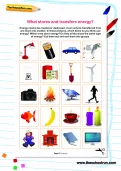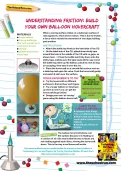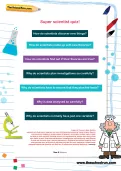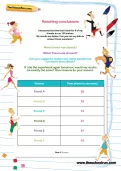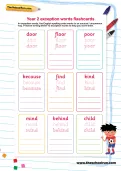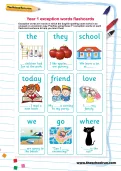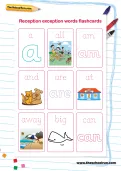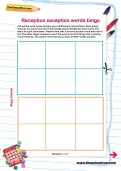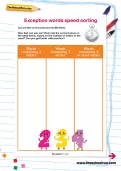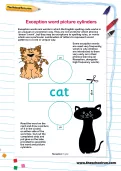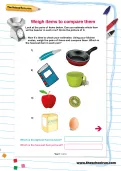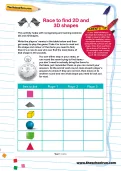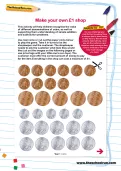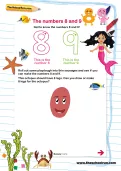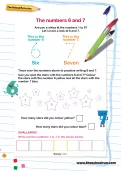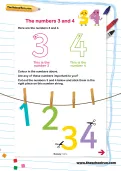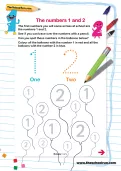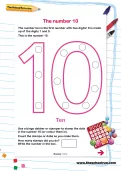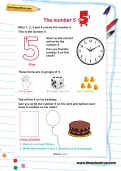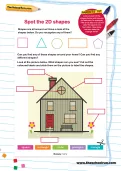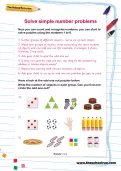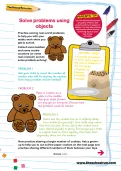In exception words, the English spelling code works in an unusual / uncommon way. Use these flashcards to help your child practise writing these Y2 common exception words.
or
Register to add to your saved resources
A colourful set of printable flashcards created by a teacher to help Year 1 children learn how to spell common exception words.
or
Register to add to your saved resources
These colourful flashcards include exception words that Reception children need to learn. They were created by a teacher to assist with learning at home.
or
Register to add to your saved resources
Let's play bingo! Each player chooses six exception words to write on their bingo board then take it in turns to pick a card and read it out. The other player checks to see if the word is on their bingo mat, crossing it out if they do. The winner is the person to cross all their words out first.
or
Register to add to your saved resources
Already a subscriber? to view this content.
Let's try some exception words speed sorting! Cut out the word cards and shuffle them. How fast can you sort them into the correct space in the table, based on the number of letters in the word?
or
Register to add to your saved resources
Already a subscriber? to view this content.
Exception words are words in which the English spelling code works in an unusual or uncommon way. Read these exception words then get out your scissors and glue! We are going to make some word and picture cylinders.
or
Register to add to your saved resources
Already a subscriber? to view this content.
How good are you at estimating what something weighs? Let's try this activity, which involves estimating the weight of common household items then checking the weight on your kitchen scales.
or
Register to add to your saved resources
Already a subscriber? to view this content.
Do you know your 2D and 3D shapes? Let's race to see who can find the most items in 30 seconds!
or
Register to add to your saved resources
Already a subscriber? to view this content.
Let's play shops! This fun game will help your child recognise the value of different denominations of coins, as well as supporting their understanding of simple addition and subtraction problems.
or
Register to add to your saved resources
Already a subscriber? to view this content.
Gather a selection of toys or household items that are different lengths and heights. Then ask your child to put them in length / height order and compare them using terms such as “longer / shorter / taller” and “double the length / half the height”.
or
Register to add to your saved resources
Already a subscriber? to view this content.
What did you do today? Let's talk about our daily routine. What is the first thing you do every day? What do you do in the morning, afternoon and night?
or
Register to add to your saved resources
Already a subscriber? to view this content.
Playdough sausages, drawing an octopus, counting passengers on a bus – discover lots of activities to help your child learn the numbers 8 and 9.
or
Register to add to your saved resources
Already a subscriber? to view this content.
Are you a whizz at the numbers 1 to 5? Let’s have a look at 6 and 7.
or
Register to add to your saved resources
Already a subscriber? to view this content.
Do you know the numbers 3 and 4? Try these fun activities to help you recognise these numbers.
or
Register to add to your saved resources
Already a subscriber? to view this content.
The first numbers you will come across at school are the numbers 1 and 2. Here are lots of activities to help you learn to spot these numbers.
or
Register to add to your saved resources
Already a subscriber? to view this content.
The number ten is the first number with two digits! It is made up of the digits 1 and 0. Here are some activities to help you recognise the number 10.
or
Register to add to your saved resources
Already a subscriber? to view this content.
After 1, 2, 3 and 4 comes the number 5! Can you spot the number 5 on a clock? Can you write the number 5 on a birthday card?
or
Register to add to your saved resources
Already a subscriber? to view this content.
Shapes are all around us! Do you recognise any of these shapes? Can you find them in your house? What shapes can you see in this picture of a house?
or
Register to add to your saved resources
Already a subscriber? to view this content.
Now you can count and recognise numbers, you can start to solve puzzles using the numbers 1 to 6.
or
Register to add to your saved resources
Already a subscriber? to view this content.
Practise solving real-world problems to help you with your maths work when you get to school. Collect some teddies and some cookie counters (or some real cookies!) and do some problem-solving!
or
Register to add to your saved resources
Already a subscriber? to view this content.
